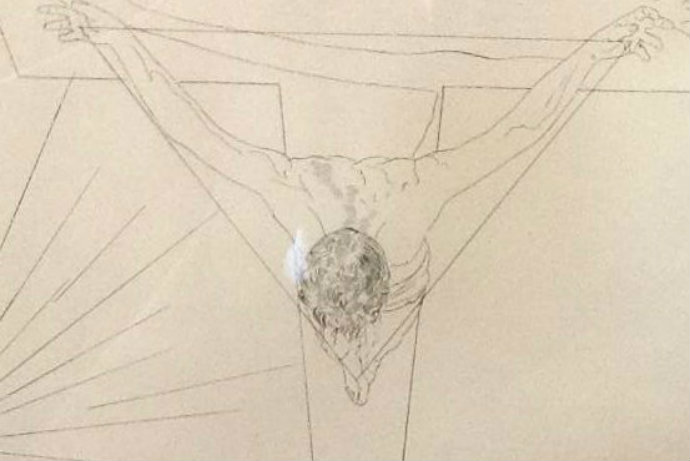Permanent Feature: Hello Dali

For this week's Permanent Feature I want to share a personal reflection about my favorite 'member' of the university's permanent art collection. A print of Salvador Dali's Crucifixion was the start of a 15+ year long scavenger hunt to find and document Wesleyan's permanent art collection. Above is a detail of the print.
I had been at Texas Wesleyan for perhaps 5 or 6 years. The art professor who hired me, Mary Apple, had just lost her battle with cancer. The mantle of Chair of the Art Department was placed on me. I proceeded to move the location of my office to better adminster this job. Within the new office in Art North was a storage closet full of prints, stretchers, paintings, lots of dust, and stuff. I began the task of cleaning out the closet to make room for more stuff. In the closet was an etching of a crucifixion in a narrow gray nondescript frame. It was signed S. Dali, 1951. What I need to point out is that Salvador Dali is one of the most reproduced artists in the world. What were the chances this was anywhere close to an original print? ANSWER: Next to none.
It just so happened I was doing research on Salvador Dali and the Surrealists to present to a combined session for the Human Prospect course. (Back then the name of such sessions were called Joint Sessions. Cultural changes required us to stop calling such sessions by that name.) I looked at that print again and realized how closely it resembled the cover image on one of the reference books I was using for research. Here is an image of that painting. You can see for yourself why I connected the two.

At the same time I was doing my research for my Human Prospect presentation, I was preparing to attend the annual College Art Association conference held in New York City. When I boarded the plane I sat in my reserved seat next to a very elderly gentleman. We politely greeted each other and I thought it was going to be a quiet plane ride with my seatmate dozing and me doing research for my presentation. I pulled out my books and the gentleman glanced over at what I was reading. He matter of factly said "Dali. I knew him." I wanted to jump up and shout and do a happy dance in the aisle. To add to my good luck the gentleman was going to the same converence I was going to. He was an art historian from Oregon, I think. I quickly closed my books and just opened my ears to listen to my perfect primary source. Our visit extended to a late dinner that night. He told me of the time Dali and his wife Gala were in New York. Dali had been hired to dress (in today's terms decorate) the street windows of Bonwitt Teller, a very prominent department store. Dali had placed dismantled and scattered maniquine parts in bathtubs and surrounding areas in a very Daliesque manner. Then the cleaning crew came in to clean overnight and thought that someone had vandalized the famous artist's creation. They put everything back in order. WRONG THING TO DO! Dali and Gala walked down the sidewalk the next day to view the artist's work from the street. When the curtains were pulled back what was revealed far from what the artist had created. He promptly found something to throw and smashed the window. Dali's reputation for being a radical in the arts and an activist for creative freedom was raised several notches that day.
Oh, by the way the elegant and delicate etching I found in Art North was appraised and determined to the real deal. It is now located in the President's outer office. You simply must go by and see it. It is a real treasure.
Read more about Dali (and other artists) at Bonwitt Teller
I hope you have enjoyed this installment of Permanent Feature and that what has been introduced to your will feed your curiosity and appreciation of the arts at Texas Wesleyan University. Are you a member of the Wesleyan family and interested in writing a short news story about your favorite work of art in the Permanent Collection? If so contact Kit Hall, khall@txwes.edu.







